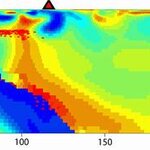Geology

By measuring how fast Earth conducts electricity and seismic waves, researchers have created a detailed picture of Mount Rainier's deep volcanic plumbing and partly molten rock that will erupt again someday.
In an odd twist, the image appears to show that at least part of Mount Rainier's partly molten magma reservoir is located about 6 to 10 miles northwest of the 14,410-foot volcano, which is 30 to 45 miles southeast of the Seattle-Tacoma area.
But that could be because the 80 electrical sensors used for the experiment were placed in a 190-mile-long, west-to-east line about 12 miles north of…

Rainwater can penetrate below the Earth's fractured upper crust, according to a new study.
It had been thought that surface water could not penetrate the ductile crust, where temperatures of more than 300°C and high pressures cause rocks to flex and flow rather than fracture, but researchers have now found fluids derived from rainwater at these levels.
Fluids in the Earth's crust can weaken rocks and may help to initiate earthquakes along locked fault lines. They also concentrate valuable metals such as gold. The new findings suggest that rainwater may be responsible for controlling…

It's not a secret that groundwater levels in Texas have declined since the Dust Bowl era - the obvious reasons are what you expect - more population and more food grown to sustain them.
But there are other key contributing factors, and the news isn't all bad, according to a new analysis. The groundwater declines have been most severe in the past four decades, according to Dr. Srinivasulu Ale, Texas A&M AgriLife Research geospatial hydrology assistant professor in Vernon.
They conducted the study because by 2060 the state's population is expected to double, increasing the…

What is the impact of volcanic sulfate emissions on climate? Researchers have completed the most accurate and precise reconstruction to date of historic volcanic sulfate emissions in the Southern Hemisphere, derived from a large number of individual ice cores collected at various locations across Antarctica and is the first annually resolved record extending through the Common Era - the last 2,000 years of human history.
Reconstructions of the past are critical to creating accurate model simulations used to assess natural versus anthropogenic climate forcing. Such model simulations underpin…

The earthquakes in central Oklahoma since 2009 are likely attributable to subsurface wastewater injection at a handful of disposal wells -
Oklahoma earthquakes constitute nearly half of all central and eastern U.S. seismicity from 2008 to 2013, many occurring in areas of high-rate water disposal.
These are legacy drilling operations, not modern natural gas fracking.
"Induced seismicity is one of the primary challenges for expanded shale gas and unconventional hydrocarbon development. Our results provide insight into the process by which the earthquakes are induced and suggest that adherence…

Tsunami earthquakes are rare but they happen at relatively shallow depths in the ocean. So while are small in terms of their magnitude, they create very large tsunamis, with some earthquakes that only measure 5.6 on the Richter scale generating waves that reach up to 30 feet high when they hit the shore.
A global network of seismometers enables researchers to detect even the smallest earthquakes. However, the challenge has been to determine which small magnitude events are likely to cause large tsunamis. New research has revealed the causes and warning signs of these rare tsunami…

Activists who are against natural gas in the United States have invented a variety of problems; flaming tap water, earthquakes, headaches, even that it will cause the earth to deflate.
Good thing they don't live in Norway, where energy extraction by the Nextdrill research project is going thousands of meters into the ground, in order to exploit another of nature's bounties: tinkering with the Earth’s molten core and radioactive isotopes in the Earth’s crust. The project is drilling down to where temperatures are so high it can be used for district heating and electricity generation.
As…

Two studies presented today at the Goldschmidt 2014 geochemistry conference in Sacramento show that the movement rate of plates carrying the Earth's crust may not be constant over time. That could provide a new explanation for the patterns observed in the speed of evolution and has implications for the interpretation of climate models.
The Earth's continental crust is an archive of Earth's history and it is the basis for studies on rock formation, the atmosphere and the fossil record - but it is not clear when and how regularly crust formed since the beginning of Earth history 4.…

There have been times in our geological history when CO2 levels were 10X what they are today, yet warming was only slightly higher.
Unlike what you often read in simplistic media accounts, there are a lot of variables in climate and weather and temperature. It takes a lot of things going wrong to turn Earth into Venus and we have never come close.
At the Goldschmidt geochemistry conference in Sacramento, geochemists discussed one such period, but they say we just got lucky - a vast mountain range formed in the middle of the ancient supercontinent, Pangea.
Around 300 million years…

How were the earth and the moon formed? A giant impact between Earth's ancestor and a planet-sized body occurred
At the Goldschmidt Geochemistry Conference in Sacramento, researchers from the University of Lorraine say that occurred 40 million years after the start of solar system formation, which makes the earth around 60 million years older than previously thought.
The geochemists discovered an isotopic signal which indicates that previous age estimates for both the Earth and the Moon are underestimates. Looking back into "deep time" it becomes more difficult to put a date on early…